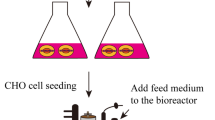Abstract
This paper presents batch culture data of the murine hybridoma, AFP-27, cultured in conventional basal media and in a nutrient-rich modified version. Expression of antibody was fivefold higher in the enriched formulation, with significant product secretion in the decline phase. Cultures were initiated at conventional inculation densities (1 ∼ 2 × 105 viable cells ml−1) and high inoculation densities (1.5 ∼ 1.7 × 106 viable cells ml−1). Amino acid levels have been reported for all cultures, with apparent differences described. Relative levels of intracellular amino acids are also reported, with significant accumulation of proline, glycine and alanine. The results have significance in the design of enriched media which are clearly beneficial for commercial production of antibodies from hybridomas.
Similar content being viewed by others
Abbreviations
- DR:
-
1:1 mixture of DMEM and RPMI, 25 mM Glucose, 4 mM Glutamine
- eDR:
-
enriched formulation based on DR
- LI:
-
low inoculum batch culture
- HI:
-
high inoculum batch culture
References
Birch JR and Boraston RC (1987) Animal cell culture, in International patent no. WO 87/00195.
Bushell ME, Bell SL, Scott MF, Snell K, Spier RE, Wardell IN and Sanders PG (1993) A three-phase pattern in growth, monoclonal antibody production and metabolite exchange in a hybridoma bioreactor culture. Biotechnol Bioeng 42: 133–139.
Cheeseman CI (1991) Molecular mechanisms involved in the regulation of amino acid transport Prog Biophys Molec Biol 55: 71–84.
Christensen HN (1985) On the strategy of kinetic discrimination of amino acid transport systems. J. Membrane 84: 97–103.
Chua F, OH SKW, Yap M and Teo WK (1992) eRDF medium enhances antibody production of IgG and IgM secreting hybridomas. In Animal Cell Technology: Basic and Applied Aspects, Vol. 5, pp. 391–396 (Proceedings of the 5th International Meeting of the Japanse Association for Animal Cell Technology, Nov. 30 – Dec. 4, Omiya, Japan), Kaminogawa S, Ametani A and Hachimura S (eds), Kluwer, Dordrecht.
Frame KK and Hu W-S (1990) Cell volume measurement as an estimation of mammalian cell biomass. Biotechnol Bioeng 36: 191–197.
Franek F and Dolnikova J (1991) Hybridoma growth and monoclonal antibody production in iron-rich protein-free medium: effect of nutrient concentration. Cytotechnology 7: 33–38: 1041–1048.
Haggstrom L (1991) The energetics of glutaminolysis — a theoretical evaluation. In Production of biologicals from animal cells in culture, Spier RE, Griffiths JB and Maignier B (eds.), Butterworth-Heinemann, Oxford pp. 79–81.
Jo E-C, Park H-J, Park J-M and Kim K-H (1990) Balanced nutrient fortification enables high-density hybridoma cell culture in batch culture Biotechnol Bioeng 36 717–722.
Kilburn DG and Webb C (1968) The cultivation of animal cells at controlled dissolved oxygen partial pressure. Biotechnol Bioeng 10:801–814.
Kun E and Kearney EB (1974) In Methods of Enzymatic Analysis, 2nd Edn., Verlag Chemie, Weinheim pp. 1802–1806.
Ljunggren J and Haggstrom L (1992) Glutamine-limited fed-batch culture reduces the overflow metabolism of amino acids in myeloma cells. Cytotechnology 8(1): 45–56.
Luan YT, Mutharasan R and Magee WE (1987) Strategies to extend the longetivity of hybridomas in culture and promote yield of monoclonal antibodies. Biotechnol Letts 9(10): 691–696.
Marquis CP, Barford JP and Harbour C (1993a) Fed-batch propagation of mouse hybridoma and human lymphoblastoid cell lines. In Animal Cell Technology : Basic and Applied Aspects: Vol. 5, Kaminogawa S, Ametani A and Hachimura S (eds.), pp. 425–431.
Marquis CP, Barford JP, Harbour C and Nobbs D (1993b) Evaluation of the batch kinetics of the amino acid metabolism of a mouse hybridoma and human lymphoblastoid cell line using a pre-column FDNDEA derivitisation, HPLC technique. Biotechnol Techn 7(11): 799–804.
Marquis CP, Barford JP, Harbour C and Fletcher A (1995a) Specific productivity of antibody producing cells in batch culture. J Biotechnol (submitted for publication). Marquis CP, Barford JP, Harbour C and Fletcher A (1996) Carbo-hydrate and amino acid metabolism during batch culture of a human kymphoblastoid cell line, BTSN6. Cytotechnology (see this issue).
Mercille S and Massie B (1994) Induction of apoptosis in nutrient-deprived cultures of hybridoma and myeloma cell. Biotechnol Bioeng 44: 1140–1154.
Murakami H (1989) Serum-free media used for cultivation of hybridomas in:Monoclonal antibodies: production and application, Alan R Liss Inc, new York, pp. 107–141.
Ozturk SS and Palsson BO (1990) Effects of dissolved oxygen on hybridoma cell growth metabolism and antibody production kinetics in continuous culture. Biotechnol Prog 6: 437–446.
Salleh M and Ardawi M (1988) Glucose and glutamine metabolism in human peripheral lymphocytes. Metabolism 37(1): 99–103.
Shotwell MA, Jayma DW, Kilberg MS and Oxender DL (1981) Neutral amino acid transport systems in chinese hamster ovary cells. J Biol Chem 256(11): 5422–5427.
Schmid G and Keller T (1992) Monitoring hybridoma metabolism in continuous suspension culture at the intracellular level. Cytotechnology 9(1-3): 217–229.
Zielke HR, Ozand PT, Tildon JT, Sevadalian DA and Comblath M (1978) Reciprocal regulation of glucose and glutamine in cultured human diploid fibroblast. J Cell Physiol 95: 41–48.
Zielke HR, Sumbilla CM, Sevdalian DA, Hawkins RL and Ozand PT (1980) Lactate: a major product of glutamine metabolism by human diploid fibroblasts. J Cell Physiol 104: 433–441.
Author information
Authors and Affiliations
Rights and permissions
About this article
Cite this article
Marquis, C.P., Barford, J.P. & Harbour, C. Amino acid metabolism during batch culture of a murine hybridoma, AFP-27. Cytotechnology 21, 111–120 (1996). https://doi.org/10.1007/BF02215661
Received:
Accepted:
Issue Date:
DOI: https://doi.org/10.1007/BF02215661




